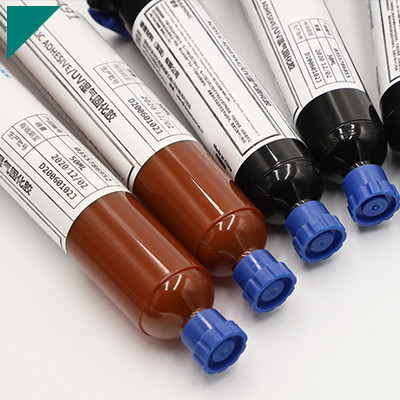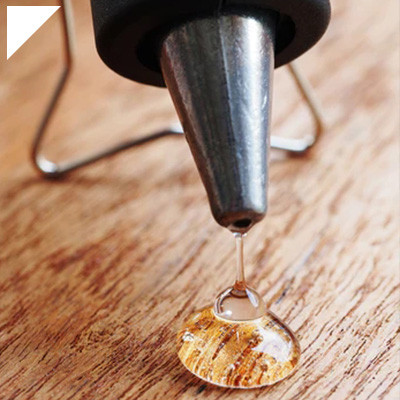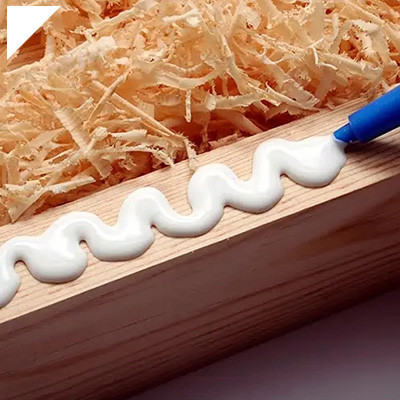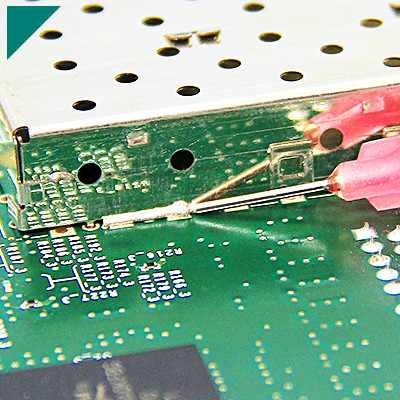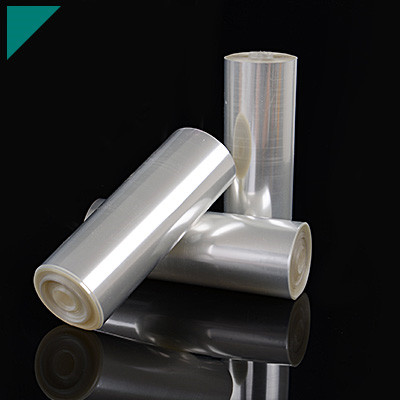Home > Potting Compound > Flexible Potting Compound
Flexible Potting Compound

The importance of flexible potting compounds in industrial applications is immeasurable. These compounds serve as essential materials for encapsulating electronic components, offering protection against moisture, vibration, and mechanical stress. As industries evolve, the demand for versatile potting compounds continues to rise, prompting exploration into their diverse uses and benefits.
Table of Contents
ToggleWhat is a flexible potting compound?
A flexible potting compound is a versatile material used in various industries to protect and insulate electronic components. It’s a sealant that provides a protective layer around delicate electronic parts, safeguarding them from environmental factors such as moisture, dust, vibration, and thermal shock. This compound is designed to remain pliable even after curing, offering resilience to movements and stresses within electronic assemblies. Because of its flexibility, it can adjust to variations in temperature and mechanical pressures without breaking or compromising the integrity of the encapsulated components.
One primary purpose of a flexible potting compound is to enhance the durability and reliability of electronic devices. Encapsulating sensitive components such as circuit boards, connectors, and sensors shields them from moisture and other contaminants that could lead to corrosion or malfunction. This protective barrier extends the lifespan of electronic equipment, making it suitable for use in challenging environments where exposure to harsh conditions is inevitable.
Unlike rigid potting materials, which can become brittle over time and crack under stress, flexible potting compounds offer superior resilience. Their ability to maintain flexibility ensures that they can withstand mechanical shocks and vibrations without compromising the performance of encapsulated components. This feature is particularly crucial in automotive electronics, aerospace systems, and industrial machinery applications, where reliability is paramount.
In addition to its protective properties, a flexible potting compound provides excellent electrical insulation. By creating a barrier between conductive elements, it prevents short circuits and electrical failures, thereby improving the safety and performance of electronic devices. This dielectric insulation is essential for applications where electrical components operate nearby, minimizing the risk of interference or damage due to electrical leakage.
The versatility of flexible potting compounds extends beyond traditional electronics to include a wide range of applications. From LED lighting fixtures to solar panels and medical devices, these materials are used in diverse industries where reliable encapsulation is essential. Their compatibility with different substrates and components makes them ideal for manufacturers seeking cost-effective solutions to protect their products from environmental hazards.
How are flexible potting compounds manufactured?
Flexible potting compounds play a crucial role in various industries, providing protection and insulation for electronic components. Understanding how these compounds are manufactured sheds light on their effectiveness and versatility. Let’s delve into the process:
Ingredient Selection:
- Manufacturers carefully choose ingredients based on the desired properties of the final product.
- Primary ingredients typically include polymers, fillers, plasticizers, and curing agents.
Polymer Preparation:
- Polymers serve as the base material of flexible potting compounds.
- Various polymers like silicones, polyurethanes, and epoxies are commonly used.
- Polymers are prepared through controlled chemical reactions to achieve the desired consistency and flexibility.
Filler Incorporation:
- Fillers are added to enhance specific properties such as thermal conductivity, flame resistance, or flexibility.
- Joint fillers include silica, ceramics, and carbon-based materials.
- Manufacturers carefully control the filler-to-polymer ratio to optimize performance without sacrificing flexibility.
Plasticizer Addition:
- Plasticizers are introduced to increase the flexibility and elongation of the compound.
- They help the compound maintain its integrity under varying temperatures and mechanical stresses.
- Selection of the appropriate plasticizer depends on factors like compatibility with polymers and the desired flexibility range.
Curing Agent Integration:
- Curing agents initiate the cross-linking reaction in the compound, transforming it from a liquid to a solid state.
- Different curing mechanisms exist, including heat, moisture, or chemical catalysts.
- Manufacturers carefully control curing parameters for the desired curing time and final properties.
Mixing and Processing:
- Once all ingredients are selected and prepared, they are thoroughly mixed to ensure homogeneity.
- Mixing is typically done using high-speed mechanical mixers or specialized mixing equipment.
- The mixture is then processed using casting, molding, or extrusion to form the final product.
Quality Control:
- Throughout the manufacturing process, stringent quality control measures are implemented.
- Testing procedures include rheological analysis, mechanical testing, and thermal analysis.
- Manufacturers ensure that each batch meets the required flexibility, adhesion, and electrical insulation specifications.
What are the primary components of flexible potting compounds?
Flexible potting compounds are essential in various industries, offering protection and insulation for sensitive electronic components. These compounds, composed of several vital elements, play a crucial role in safeguarding electronics from environmental factors, mechanical stress, and other hazards. Let’s delve into the primary constituents that make up flexible potting compounds:
Key Components:
Resin System:
- Epoxy Resin:A common choice due to its excellent adhesion and resistance to chemicals and moisture.
- Polyurethane Resin:Known for its flexibility and durability, it is ideal for applications where thermal cycling and mechanical stress are prevalent.
- Silicone Resin: Offers exceptional temperature resistance and electrical insulation properties, suitable for extreme environments.
Fillers:
- Inorganic Fillers (e.g., silica, alumina):Enhance mechanical properties such as hardness, abrasion resistance, and thermal conductivity.
- Organic Fillers (e.g., carbon black, graphite): Improve electrical conductivity and shield electromagnetic interference (EMI).
- Microspheres:Reduce density and weight while also improving thermal insulation properties.
Modifiers:
- Plasticizers:Increase flexibility and impact resistance, ensuring the compound can withstand bending and vibrations without cracking.
- Flame Retardants:Enhance the fire resistance of the compound, which is crucial for applications where safety is a priority.
- UV Stabilizers:Protect against degradation caused by exposure to ultraviolet (UV) radiation, extending the lifespan of the potting material in outdoor applications.
Curing Agents:
- Amine-based: This is commonly used with epoxy resins to initiate the curing process, resulting in a strong, cross-linked network.
- Isocyanates:React with polyols in polyurethane resins to form urethane linkages, providing excellent adhesion and chemical resistance.
- Platinum Catalysts:Facilitate the curing of silicone resins, allowing for room temperature or heat-assisted curing options.
Additives:
- Thickeners:Adjust viscosity for more accessible application and better control over the flow of the compound during potting.
- Colorants:Provide visual identification and differentiation between various potting compounds, aiding in quality control and product identification.
- Antioxidants:Prevent oxidation and degradation of the compound, ensuring long-term stability and reliability.
What industries utilize flexible potting compounds?
Flexible potting compounds have become indispensable materials across various industries, offering robust protection and insulation for sensitive electronic components. Because of their unique qualities, they are the best option for applications where dependability, flexibility, and durability are crucial. Let’s delve into the diverse industries that heavily rely on flexible potting compounds:
Electronics Industry:
- Flexible potting compounds are extensively used in the electronics industry to encapsulate delicate electronic components such as circuit boards, sensors, and connectors.
- They provide exceptional protection against moisture, dust, vibrations, and thermal shocks, ensuring the longevity and reliability of electronic devices even in harsh environments.
- Typical applications include LED lighting, automotive electronics, consumer electronics, and industrial controls.
Automotive Sector:
- In the automotive sector, flexible potting compounds play a crucial role in safeguarding electronic control units (ECUs), sensors, and wiring harnesses from environmental stresses encountered on the road.
- These compounds offer excellent resistance to temperature variations, chemicals, and mechanical impacts, thus enhancing automotive electronics’ overall durability and performance.
- Applications range from engine control modules to advanced driver assistance systems (ADAS) components.
Renewable Energy:
- Flexible potting compounds in renewable energy systems such as solar panels and wind turbines protect sensitive components like inverters, controllers, and sensors from harsh outdoor conditions.
- They help prevent moisture ingress, UV degradation, and thermal cycling effects, thereby ensuring the reliability and efficiency of renewable energy installations.
- These compounds contribute to the longevity of renewable energy systems, reducing maintenance costs and enhancing overall sustainability.
Aerospace and Defense:
- The aerospace and defense sectors rely on flexible potting compounds for encapsulating critical electronic assemblies in aircraft, spacecraft, missiles, and military equipment.
- These compounds meet stringent performance requirements, including resistance to high altitudes, extreme temperatures, shock, and vibration.
- They play a vital role in ensuring the functionality and safety of electronic systems used in navigation, communication, avionics, and weapon systems.
Medical Devices:
- Flexible potting compounds are essential in the medical device industry for encapsulating electronic components in devices such as pacemakers, defibrillators, and diagnostic equipment.
- They offer biocompatibility, sterilizability, and chemical resistance, meeting the stringent regulatory standards of the healthcare sector.
- These compounds help maintain the integrity and reliability of electronic medical devices, contributing to improved patient outcomes and safety.
What are the advantages of using flexible potting compounds?
Protecting delicate components from harsh environmental conditions is paramount in electronics and manufacturing. It is where flexible potting compounds come into play, offering a range of advantages that make them indispensable in various industries. Let’s delve into why these compounds are gaining traction and how they can benefit your projects:
Advantages of Using Flexible Potting Compounds:
- Shock Absorption:One of their main benefits is the capacity of flexible potting compounds to withstand shocks and vibrations. This feature is crucial for safeguarding sensitive electronic components from mechanical stress, ensuring their longevity and reliability.
- Thermal Management:Flexible potting compounds excel in dissipating heat, essential for maintaining optimal operating temperatures of electronic devices. By efficiently transferring heat away from components, these compounds prevent overheating and subsequent damage, thus enhancing the overall performance and lifespan of the equipment.
- Chemical Resistance:Industries exposed to harsh chemicals and solvents require robust protection for their electronic assemblies. Flexible potting compounds ensure the integrity of the encapsulated components even in the most challenging circumstances by providing exceptional resistance to a wide range of chemicals, including lubricants, fuels, and cleaning agents.
- Waterproofing:Moisture ingress poses a significant threat to electronic devices, leading to corrosion and malfunction. Flexible potting compounds create a watertight seal around encapsulated components, shielding them from moisture and environmental contaminants. This waterproofing feature mainly benefits outdoor applications or devices operating in humid conditions.
- Electrical Insulation:Ensuring electrical insulation prevents short circuits and electrical failures. Flexible potting compounds provide reliable insulation, protecting components from electrical arcing and breakdown, even in high-voltage environments. This feature is indispensable in electronics manufacturing, where signal integrity and safety are paramount.
- Customization and Versatility:Flexible potting compounds come in various formulations to meet specific application requirements. Manufacturers can tailor the compounds’ properties, such as hardness, flexibility, and curing time, to suit different needs. This versatility allows for encapsulating various components, from tiny circuit boards to large industrial machinery.
- Ease of Application:With user-friendly application processes such as pouring, injection molding, or dispensing, flexible potting compounds offer ease of use for manufacturers. They need little effort to completely encapsulate and safeguard electronic assemblies because they can fill complicated gaps and conform to complex forms.
How do flexible potting compounds protect electronic components?
In the intricate world of electronics, safeguarding components against environmental factors and mechanical stress is paramount. One crucial element in this endeavor is the use of flexible potting compounds. These specialty materials protect sensitive electronic components from moisture, chemicals, vibration, and thermal stress. Understanding how flexible potting compounds work to fortify electronic components is essential for ensuring the reliability and longevity of electronic devices.

Flexible potting compounds, typically silicone or polyurethane, offer several key benefits in electronic component protection. Because of their elasticity, they can successfully encapsulate delicate elements and conform to unusual shapes. This conformal coating creates a barrier that seals out moisture and contaminants, preventing corrosion and short circuits that can compromise the functionality of electronic devices.
One of the primary functions of flexible potting compounds is to provide mechanical support and shock absorption. Electronic components often undergo various mechanical stresses during operation, such as vibration and impact. Manufacturers can lessen the possibility of physical damage and increase the longevity of the electronics by encasing these components in a flexible potting compound that absorbs shocks and dampens vibrations.
Moreover, flexible potting compounds offer excellent thermal conductivity, helping to dissipate heat generated by electronic components. Heat dissipation is essential to keeping components operating at peak efficiency and avoiding overheating, which can result in component failure. By efficiently transferring heat away from sensitive parts, flexible potting compounds contribute to electronic devices’ overall reliability and efficiency, especially in applications where thermal management is critical.
Another advantage of flexible potting compounds is their ability to maintain electrical insulation properties over various temperatures. This insulation helps prevent electrical leakage and short circuits, ensuring electronic circuits’ safe and reliable operation even in challenging environments.
In addition to their protective functions, flexible potting compounds facilitate easier assembly and handling of electronic components during manufacturing. Their low viscosity and flowability allow for precise application, ensuring uniform coverage and eliminating voids or air pockets that could compromise protection.
Can flexible potting compounds withstand extreme temperatures?
Flexible potting compounds are essential materials in various industries, offering protection and stability to electronic components. One critical question surrounding these compounds is their ability to endure extreme temperatures. Let’s delve into this inquiry and explore the capabilities of flexible potting compounds when facing temperature challenges.
Factors Influencing Temperature Resistance:
- Chemical Composition:The composition of flexible potting compounds is crucial in determining their temperature resistance. Silicones and polyurethanes are common materials known for their thermal stability.
- Additives:Certain additives, such as heat-resistant fillers or flame retardants, can enhance the temperature resistance of potting compounds.
- Application Technique:Proper application techniques ensure uniform coverage and adequate thickness, which contribute to better temperature resistance.
Extreme Temperature Tests:
- High-Temperature Endurance:Flexible potting compounds undergo testing in environments with elevated temperatures to assess their performance under heat stress.
- Low-Temperature Endurance:Similarly, compounds are subjected to low-temperature conditions to evaluate their resilience in cold environments.
- Results and Performance:
- High-Temperature Resistance:Many flexible potting compounds exhibit excellent resistance to high temperatures, withstanding heat levels exceeding 150°C or more, depending on the specific formulation.
- Low-Temperature Resistance:These compounds demonstrate impressive resilience in cold environments, remaining flexible and durable even at temperatures below -40°C.
Applications in Extreme Environments:
- Automotive Industry:Flexible potting compounds are used in automotive electronics, where components are exposed to high under-the-hood temperatures and freezing conditions.
- Aerospace and Defense:These compounds provide vital protection in aerospace and defense applications, where electronics may encounter extreme temperature fluctuations during flight or in outer space.
- Industrial Electronics:In industrial settings where machinery operates in harsh conditions, flexible potting compounds safeguard sensitive electronic components from temperature variations.
Are there different types of flexible potting compounds available?
Regarding safeguarding electronic components from environmental hazards, flexible potting compounds emerge as versatile solutions. However, not all potting compounds are created equal. A diverse array of formulations are tailored to meet specific application requirements. Let’s delve into the world of flexible potting compounds and explore the different types available:
Types of Flexible Potting Compounds:
- Silicone-Based Compounds:Silicone-based potting compounds offer exceptional flexibility and thermal stability. They excel in high-temperature applications, providing reliable protection against heat and thermal cycling. Silicone compounds also exhibit excellent resistance to moisture, chemicals, and UV exposure, making them ideal for outdoor and harsh environment applications.
- Polyurethane Compounds:Polyurethane potting compounds are prized for superior electrical insulation properties and robust mechanical strength. They are highly adhesive to various substrates and resistant to harsh environmental factors, including temperature changes and mechanical strain. Polyurethane compounds are commonly used in automotive, aerospace, and industrial applications.
- Epoxy Resin Compounds:Epoxy resin potting compounds are renowned for their high bond strength and exceptional chemical resistance. They provide excellent protection against moisture ingress and environmental contaminants, making them suitable for demanding applications such as marine electronics and underground installations. Epoxy compounds cure to a hard, durable finish and offer superior dimensional stability over a wide temperature range.
- Hybrid Compounds:Hybrid potting compounds combine the advantageous properties of different resin systems to achieve optimal performance. For example, a hybrid formulation may blend silicone for flexibility with epoxy for enhanced adhesion and mechanical strength. These compounds offer a tailored approach to encapsulation, catering to specific application requirements while maximizing performance and reliability.
- Thermoplastic Compounds:Thermoplastic potting compounds offer unique benefits such as reworkability and recyclability. Unlike thermosetting resins that cure irreversibly, thermoplastics soften when heated, allowing for easy removal and rework of encapsulated components. This feature is advantageous in applications where frequent modifications or repairs are anticipated.
- Specialized Formulations:In addition to the standard resin systems, specialized formulations of flexible potting compounds cater to niche applications. For instance, low-outgassing compounds are essential for aerospace and vacuum applications to prevent contamination, while flame-retardant compounds meet stringent safety requirements in electronics manufacturing.
What considerations are important when selecting a flexible potting compound?
When sealing and protecting electronic components, a crucial decision lies in selecting the appropriate potting compound. Among the array of options available, a flexible potting compound stands out for its ability to provide both protection and flexibility, ensuring the longevity and reliability of electronic devices. Here are the key considerations to keep in mind when selecting a flexible potting compound:
Material Compatibility:
- Ensure compatibility with the materials of the components being potted.
- Check for potential reactions between the potting compound and the substrate, especially if it involves sensitive materials like certain plastics or metals.
Environmental Conditions:
- Evaluate the operating environment of the electronic device.
- Consider elements like extremes in temperature, moisture exposure, chemical exposure, and UV radiation.
- Choose a flexible potting compound with appropriate resistance to these environmental stressors to prevent long-term degradation.
Flexibility and Shock Absorption:
- Assess the degree of flexibility required for the application.
- Opt for a potting compound that offers sufficient flexibility to accommodate thermal expansion, contraction, and mechanical stress without compromising the integrity of the seal.
- Look for compounds with excellent shock absorption properties to protect delicate components from mechanical vibrations and impacts.
Electrical Insulation Properties:
- Ensure that the potting compound provides effective electrical insulation.
- Verify its dielectric strength and insulation resistance to prevent electrical leakage or short circuits.
- Select a compound with low electrical conductivity to maintain the electrical integrity of the encapsulated components.
Adhesion and Curing Properties:
- Consider the adhesion characteristics of the potting compound to the substrate.
- Look for compounds that adhere well to various surfaces, including metals, plastics, and ceramics.
- Evaluate the curing time and process compatibility with the manufacturing requirements to ensure efficient production without compromising quality.
How do flexible potting compounds contribute to product longevity?
Flexible potting compounds are crucial in extending the lifespan of electronic devices and components by providing robust protection against environmental stressors. Let’s explore how these compounds contribute to product longevity:
Sealing Out Environmental Hazards:
- Flexible potting compounds create a protective barrier around electronic components, sealing out moisture, dust, and other environmental contaminants.
- Potting compounds shield delicate electronics from corrosion and degradation by preventing the ingress of water and corrosive substances, thus extending their operational lifespan.
Absorbing Mechanical Stress:
- Electronics are often subjected to mechanical shocks and vibrations during transportation, operation, or maintenance.
- Flexible potting compounds act as shock absorbers, dampening vibrations, and cushioning components against impact, reducing the risk of physical damage and premature failure.
Thermal Management:
- Overheating is a common cause of electronic failure, particularly in devices with high power densities or harsh environments.
- Flexible potting compounds with thermal conductivity properties dissipate heat away from sensitive components, maintaining optimal operating temperatures and prolonging their lifespan.
Preventing Electrical Failures:
- Electrical insulation is critical for preventing short circuits and electrical breakdowns that can lead to device failure or safety hazards.
- Flexible potting compounds provide reliable insulation, protecting against moisture-induced conductivity and ensuring uninterrupted operation over the product’s lifetime.
Adapting to Environmental Conditions:
- Flexible potting compounds exhibit resilience to temperature extremes, UV exposure, and chemical exposure.
- Their ability to withstand diverse environmental conditions ensures consistent performance and reliability, even in challenging applications such as outdoor electronics or industrial machinery.
Facilitating Repairs and Maintenance:
- Flexible potting compounds can be made for simple rework or repair in the case of component failure or damage.
- Their flexibility allows for removing and replacing encapsulated components without compromising the integrity of the overall assembly, minimizing downtime and extending the product’s service life.
Are there any environmental concerns associated with flexible potting compounds?
Flexible potting compounds are indispensable in various industries and are renowned for protecting electronic components from environmental stresses such as moisture, chemicals, and vibrations. However, amidst their functional benefits, questions arise about their ecological implications. Let’s delve into the environmental concerns associated with flexible potting compounds:
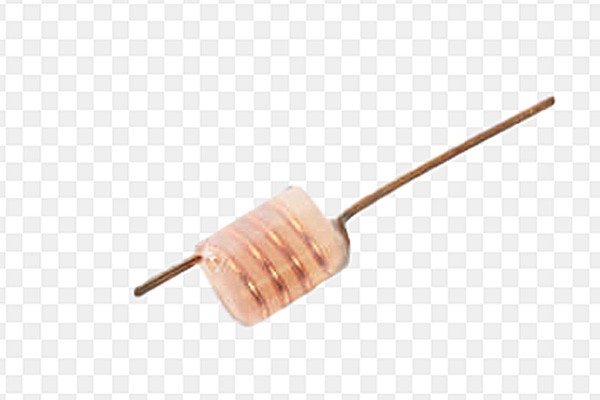
Chemical Composition:
- Flexible potting compounds often contain a mix of synthetic polymers, fillers, and additives.
- Some formulations may include hazardous chemicals such as volatile organic compounds (VOCs), plasticizers, and flame retardants.
End-of-Life Disposal:
- Disposal of electronic devices encapsulated with flexible potting compounds poses challenges.
- Improper disposal can lead to leaching of hazardous chemicals into soil and water bodies, contributing to environmental pollution.
Recycling Limitations:
- The complex composition of flexible potting compounds makes it difficult to recycle electronic components.
- Separating these compounds from electronic waste for recycling requires specialized processes, adding to the complexity and cost.
Energy Consumption:
- Manufacturing flexible potting compounds involves energy-intensive processes.
- Degradation of the environment and greenhouse gas emissions are linked to high energy usage.
Long-Term Durability:
- While flexible potting compounds enhance the longevity of electronic devices, their durability over time is a concern.
- Degradation of these compounds may release harmful substances into the environment during the lifespan of electronic devices.
Addressing Environmental Concerns:
To try to mitigate the harm that flexible potting materials cause to the environment:
- Research and Development:Scientists are exploring eco-friendly alternatives and improving the biodegradability of potting compounds.
- Regulatory Compliance:Stringent regulations are being enforced to restrict the use of hazardous chemicals in potting compound formulations, promoting safer and more sustainable options.
- Recycling Initiatives:Innovations in electronic waste recycling technologies aim to recover and reuse materials efficiently, including flexible potting compounds, reducing the environmental footprint of electronic devices.
What role do flexible potting compounds play in electrical insulation?
Among the components and materials utilized in electrical systems, flexible potting compounds stand out as indispensable players. These compounds provide robust electrical insulation and safeguard delicate electronic components from environmental hazards, mechanical stresses, and electrical faults.
Flexible potting compounds are specially formulated materials designed to encapsulate and protect electronic assemblies. They offer a myriad of benefits beyond conventional insulation methods. Their versatility lies in their ability to conform to irregular shapes, penetrate intricate spaces, and adhere firmly to various substrates. This adaptability makes them invaluable in applications where traditional insulation materials fall short.
One of the primary functions of flexible potting compounds is to provide effective electrical insulation. In electronic devices and systems, where components are densely packed and operate in demanding environments, insulation is crucial to prevent short circuits, leakage currents, and electrical breakdowns. Flexible potting compounds create a barrier that effectively isolates conductive elements, thereby minimizing the risk of electrical malfunctions and enhancing overall system reliability.
Moreover, these compounds excel in withstanding a wide range of environmental stresses. Whether exposed to temperature extremes, moisture, chemicals, or mechanical vibrations, flexible potting compounds maintain their integrity, ensuring sustained protection for sensitive electronics. This resilience extends the operational lifespan of electronic devices, making them suitable for diverse applications across industries.
Another standout feature is their flexibility. Unlike rigid encapsulants, which may crack or delaminate under stress, flexible potting compounds offer enhanced shock absorption and vibration-dampening properties. This flexibility protects components from mechanical impacts and accommodates thermal expansion and contraction, mitigating the risk of damage caused by thermal cycling.
Furthermore, potting with flexible compounds is relatively straightforward, facilitating efficient manufacturing and assembly. Whether applied through manual dispensing or automated potting systems, these compounds flow easily into cavities, ensuring complete encapsulation of electronic assemblies. This ease of application translates into cost savings and increased productivity for manufacturers.
Can flexible potting compounds be customized for specific applications?
Flexible potting compounds are materials used to encapsulate electronic components, protecting against moisture, dust, vibration, and thermal shock. They are typically elastomeric in nature and offer both flexibility and durability.
Versatility Through Customization:
- Material Composition: Flexible potting compounds can be tailored by adjusting their material composition. This customization allows varying degrees of flexibility, adhesion, thermal conductivity, and chemical resistance to meet specific application requirements.
- Viscosity and Cure Time: Manufacturers can modify flexible potting compounds’ viscosity and cure time to suit different production processes and application needs. This customization ensures optimal flow and curing characteristics, enhancing operational efficiency.
- Environmental Resistance: Customization enables the formulation of flexible potting compounds with enhanced resistance to harsh environmental factors such as extreme temperatures, UV exposure, and chemicals. This adaptability ensures long-term reliability in diverse operating conditions.
Applications of Customized Flexible Potting Compounds:
- Automotive Electronics: Customized flexible potting compounds protect electronic vehicle components from moisture, vibration, and thermal stress. They enable the miniaturization of electronics while ensuring reliability in demanding automotive environments.
- Aerospace and Defense: In aerospace and defense applications, where components are subjected to extreme conditions, customized, flexible potting compounds protect against shock, vibration, and temperature variations. Their adaptability allows for the encapsulation of sensitive electronics in critical systems.
- Consumer Electronics: Customized, flexible potting compounds that offer protection against moisture ingress and mechanical stress enhance the reliability of electronic devices, benefiting the consumer electronics industry. These compounds enable the design of durable and reliable electronic devices, improving their lifespan and performance.
Future Trends and Innovations:
Continuous research and development efforts are focused on further enhancing flexible potting compounds’ customization options and performance characteristics. Advances in materials science and manufacturing processes are driving innovation, leading to more tailored solutions for specific applications.
How do flexible potting compounds compare to rigid potting compounds?
Choosing a suitable potting compound is crucial for ensuring optimal performance and durability in electronic encapsulation. Among the various types available, flexible and rigid potting compounds stand out as popular choices. Let’s delve into a comparative analysis to understand the differences and advantages between these two options.
Flexible Potting Compounds:
- Material Characteristics:Flexible potting compounds are typically made of elastomers or silicone-based materials, offering a high degree of flexibility and elasticity.
- Shock Absorption:One key benefit of flexible potting compounds is their ability to absorb mechanical shocks and vibrations, making them ideal for applications subjected to frequent movement or impact.
- Thermal Expansion:These compounds exhibit excellent thermal expansion properties, allowing them to accommodate temperature variations without cracking or compromising the integrity of the encapsulated electronics.
- Environmental Protection:Flexible potting compounds protect against moisture, chemicals, and other ecological factors, shielding sensitive electronic components from potential damage.
- Ease of Application:They are relatively easy to apply, flow readily into intricate spaces, and can conform to irregular shapes, ensuring complete coverage and insulation of the encapsulated electronics.
Rigid Potting Compounds:
- Material Characteristics:Rigid potting compounds are typically epoxy-based resins or urethanes, offering high structural strength and rigidity.
- Mechanical Stability:Rigid compounds provide excellent mechanical stability, maintaining the structural integrity of encapsulated components even under high loads or pressure.
- Dimensional Stability:They exhibit minimal shrinkage upon curing, ensuring precise dimensional stability and maintaining tight tolerances for electronic assemblies.
- Chemical Resistance:Rigid potting compounds offer good resistance to a wide range of chemicals, enhancing the longevity of encapsulated electronics in harsh environments.
- High-Temperature Resistance:These compounds can withstand elevated temperatures without softening or degrading, making them suitable for applications exposed to heat.
Comparative Analysis:
- Flexibility vs. Rigidity:Flexible potting compounds offer greater flexibility and elasticity, whereas rigid compounds provide higher structural strength and rigidity.
- Shock Absorption vs. Mechanical Stability:Flexible compounds excel in shock absorption, while rigid compounds prioritize mechanical stability.
- Application Scenarios:Flexible compounds are ideal for applications requiring vibration damping and environmental protection, while rigid compounds are preferred for structural reinforcement and dimensional stability.
What are the challenges faced in the application of flexible potting compounds?
Flexible potting compounds are elastomeric materials that encapsulate electronic assemblies, protecting environmental factors such as moisture, vibration, and thermal stress. Their flexibility allows them to conform to intricate shapes and offer excellent electrical insulation.
Challenges Faced in Application:
- Adhesion Issues:Achieving proper adhesion between the potting compound and substrate ensures long-term reliability. Challenges such as poor surface preparation or incompatible materials can lead to adhesion failures, compromising the effectiveness of the potting.
- Thermal Management: Electronic component overheating can only be avoided with effective thermal control. However, selecting a flexible potting compound with inadequate thermal conductivity can result in heat buildup, leading to performance degradation and premature failure.
- Cure Time: The curing time of potting compounds can impact production efficiency. Longer cure times may delay assembly processes, increasing manufacturing costs and affecting productivity. Balancing cure time with performance requirements is crucial for optimizing production schedules.
- Compatibility with Components: Specific electronic components may be sensitive to the chemicals present in potting compounds. Compatibility issues can arise if the potting material interacts adversely with the elements, leading to functionality issues or degradation over time.
- Environmental Resistance:Flexible potting compounds are often exposed to harsh environmental conditions, including moisture, chemicals, and UV radiation. Ensuring that the chosen compound offers adequate resistance to these factors is essential for maintaining performance and reliability in challenging environments.
- Mechanical Properties: Flexibility is a key characteristic of potting compounds, allowing them to absorb mechanical stresses and vibrations. However, if the material is too rigid or soft, it may fail to provide sufficient protection against shocks and impacts, compromising the integrity of the encapsulated electronics.
- Cost Considerations: While flexible potting compounds offer numerous benefits, their cost can vary significantly depending on material composition, performance characteristics, and application requirements. Achieving optimal value without compromising on quality requires balancing cost and functionality.
Are there any notable innovations in the field of flexible potting compounds?
In the ever-evolving landscape of industrial materials, flexible potting compounds have emerged as a significant innovation, offering versatile solutions across various sectors. These compounds, designed to protect electronic components from environmental stresses, are witnessing notable advancements, revolutionizing their applications and effectiveness.
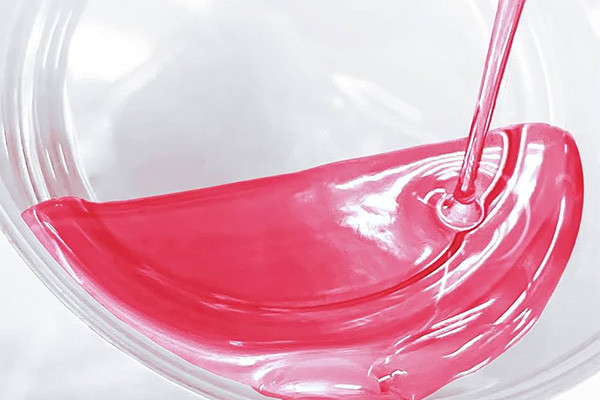
Innovations:
- Enhanced Flexibility:Traditionally, potting compounds were rigid, limiting their use in applications requiring flexibility. However, recent innovations have led to the development of highly flexible formulations capable of accommodating movement and vibration without compromising protection. This breakthrough has expanded the scope of applications, especially in industries where flexibility is crucial, such as automotive and aerospace.
- Improved Thermal Management:Managing heat dissipation is one of the critical challenges in electronics. Advanced flexible potting compounds now incorporate thermal management properties, efficiently dissipating heat from sensitive components. It guarantees that electronic gadgets operate at their best and last long, especially under harsh conditions with wide temperature swings.
- Chemical Resistance:Industrial environments often expose electronic components to various chemicals, posing a risk of corrosion and degradation. Innovative, flexible potting compounds offer superior chemical resistance, safeguarding electronics against corrosive agents and extending their lifespan. This innovation is precious in industries such as oil and gas, where exposure to harsh chemicals is essential.
- Enhanced Adhesion:Proper adhesion is crucial for the effectiveness of potting compounds in protecting electronic assemblies. Recent advancements have led to the development of formulations with improved adhesion properties, ensuring a solid bond with substrates and preventing moisture ingress or delamination. This enhancement contributes to the reliability and durability of potted electronics in challenging conditions.
- Environmental Sustainability:The need for eco-friendly materials in industrial applications is expanding as sustainability becomes more and more of a priority. Innovative, flexible potting compounds now incorporate biodegradable and environmentally friendly components, reducing their environmental impact without compromising performance. It aligns with the industry’s goals of minimizing carbon footprint and promoting sustainable practices.
How do flexible potting compounds impact the performance of electronic devices?
In the world of electronic devices, where precision and reliability are paramount, the choice of materials used in their construction can significantly affect performance and durability. One such crucial material is the flexible potting compound. These compounds protect electronic components from environmental factors such as moisture, vibrations, and thermal stress, ultimately impacting overall performance and longevity.
Flexible potting compounds, often made from silicone or polyurethane, offer unique properties that make them ideal for various electronic applications. Because of their versatility, they can take on the form of complex components and provide a safe and secure encapsulation. As opposed to stiff potting materials like epoxy resins, flexible compounds can absorb mechanical shocks and vibrations, lowering the possibility of damage to delicate electronics, particularly in harsh conditions.
Moisture infiltration can lead to corrosion, short circuits, and eventual failure in electronic devices, making them especially sensitive. Flexible potting compounds create an airtight seal around components, preventing moisture from seeping in and compromising performance. This moisture resistance is particularly crucial in outdoor or harsh industrial settings where exposure to humidity and moisture is inevitable.
Furthermore, the thermal stability of flexible potting compounds is a crucial factor in maintaining electronic device performance. These compounds can withstand a wide range of temperatures without degrading, ensuring consistent operation even in extreme conditions. By effectively dissipating heat, they help prevent overheating of electronic components, which can lead to performance degradation or failure.
In applications where space is limited, or components are densely packed, the flexibility of potting compounds becomes even more critical. Unlike rigid encapsulants, which may crack or break under stress, flexible compounds can accommodate dimensional changes without compromising the integrity of the encapsulation. This flexibility also simplifies the manufacturing process, allowing for easier assembly and reducing the risk of damage during handling.
Another significant advantage of flexible potting compounds is their electrical insulation properties. By forming a protective barrier around conductive elements, these compounds help to prevent electrical shorts and leakage currents, ensuring the reliable operation of electronic circuits. This insulation is essential in high-voltage applications, where any insulation breakdown could lead to catastrophic consequences.
Can flexible potting compounds be recycled or disposed of sustainably?
These substances act as barriers, protecting sensitive electronic parts from external dangers, including vibration, dampness, and heat stress. Among the myriad options available, flexible potting compounds stand out for their unique ability to adapt to the contours of intricate assemblies while maintaining robust protection. However, an important question looms over their usage: Can flexible potting compounds be recycled or disposed of sustainably? Let’s delve deeper into this query.
Understanding Flexible Potting Compounds:
- Flexible potting compounds are formulations designed to provide protection and resilience to electronic assemblies.
- They exhibit a high degree of flexibility, enabling them to absorb shocks and vibrations. This makes them ideal for applications in the automotive, aerospace, and consumer electronics industries.
- These compounds typically comprise polymers such as silicones or polyurethanes, which impart the desired flexibility and durability.
Challenges in Recycling:
- The complex composition of flexible potting compounds poses challenges for recycling initiatives.
- Separating these compounds from electronic components without damaging them is a daunting task.
- Contamination from other materials used in electronics further complicates recycling efforts.
Sustainable Disposal Options:
Despite the recycling challenges, several sustainable disposal options can be explored:
- Energy Recovery: Incineration of flexible potting compounds in controlled environments can harness energy while minimizing environmental impact.
- Biodegradation:Research into biodegradable potting compounds is ongoing. Creating formulations that decompose spontaneously over time minimizes the need for conventional disposal techniques.
- Material Innovation:Advancements in material science may lead to the development of recyclable or upcycle potting compounds, facilitating circular economy principles within the electronics industry.
Industry Initiatives and Regulations:
- Regulatory bodies increasingly focus on extended producer responsibility (EPR), urging manufacturers to design products with end-of-life considerations in mind.
- Collaborative efforts between industry stakeholders and waste management entities are essential for establishing efficient recycling infrastructure and standards.
What future developments are anticipated in the realm of flexible potting compounds?
Flexible potting compounds have become indispensable in protecting electronic components from environmental factors, mechanical stress, and chemical exposure. As technology advances and industrial demands evolve, the realm of flexible potting compounds is expected to witness significant developments aimed at enhancing performance, sustainability, and versatility.
Anticipated Developments:
- Nanostructured Formulations:Researchers are exploring integrating nanostructured materials into potting compound formulations. These nanostructures offer unique properties such as improved mechanical strength, enhanced thermal conductivity, and superior barrier properties. By incorporating nanotechnology, future potting compounds could achieve unprecedented levels of protection and performance.
- Self-Healing Properties:One of the anticipated advancements is the incorporation of self-healing mechanisms into flexible potting compounds. Inspired by biological systems, these compounds would autonomously repair minor damages, such as cracks or punctures, thereby extending the lifespan of electronic assemblies and reducing maintenance requirements.
- Adaptive Flexibility:Future developments may focus on creating flexible potting compounds with adaptive flexibility. These compounds would possess the ability to adjust their stiffness or flexibility in response to changing environmental conditions or mechanical stresses. This adaptive behavior would optimize protection while ensuring compatibility with various electronic components and substrates.
- Biocompatible Formulations:With the increasing integration of electronics in medical devices and wearable technologies, there is a growing demand for biocompatible potting compounds. Anticipated developments involve the formulation of flexible potting compounds using materials that are compatible with biological tissues, ensuring safe and reliable performance in medical and healthcare applications.
- Enhanced Sustainability:Sustainable manufacturing practices are gaining prominence across industries. FutureFuture advancements in flexible potting compounds are anticipated to put sustainability first by using renewable resources, consuming less energy during manufacture, and producing less waste. Biodegradable and recyclable formulations may become standard, aligning with global efforts toward environmental conservation.
How do cost considerations influence the selection of flexible potting compounds?
Flexible potting compounds are pivotal in protecting electronic components from environmental factors such as moisture, chemicals, and mechanical stress. However, when selecting a suitable compound, cost considerations become paramount. Understanding how cost influences the decision-making process is crucial for businesses aiming to balance quality and affordability.
Factors Influencing Cost Considerations:
- Material Composition:The ingredients used in flexible potting compounds greatly influence their cost. Compounds formulated with high-quality materials may come at a higher price point due to enhanced performance and durability.
- Performance Specifications:Meeting specific performance requirements, such as temperature resistance, electrical insulation, and vibration dampening, can affect the cost. Compounds engineered to meet stringent standards often entail higher production costs, impacting their market price.
- Application Complexity:The complexity of the potting application can significantly impact costs. Compounds designed for intricate geometries or challenging environments may require specialized formulations or application techniques, leading to increased expenses.
- Volume Requirements:Bulk purchasing typically results in cost savings. Businesses requiring large volumes of flexible potting compounds can negotiate favorable pricing with suppliers, reducing the overall expenditure per unit.
- Lifecycle Considerations:Evaluating the long-term costs of the selected potting compound is essential. While higher initial costs may deter some, compounds offering extended durability and reliability can result in significant savings over their lifecycle.
Navigating Cost-Effective Solutions:
- Comparative Analysis:It is crucial to conduct a thorough comparison of available products based on cost, performance, and reliability.
- Customization Opportunities:Some suppliers offer customization services tailored to specific application requirements. While customization may entail initial setup costs, it can result in optimized performance and reduced wastage, ultimately contributing to long-term cost savings.
- Supplier Partnerships:Cultivating solid partnerships with reliable suppliers can yield benefits in pricing, technical support, and product innovation. Collaborating closely with suppliers allows businesses to leverage their expertise and negotiate favorable terms.
- Quality Assurance:Setting quality assurance procedures as a top priority reduces the possibility of expensive rework or defective products. Investing in certified compounds from reputable suppliers ensures consistent performance and reliability, ultimately minimizing overall costs.
Conclusion
In conclusion, flexible potting compounds represent a cornerstone in modern industrial practices, providing invaluable protection and resilience to electronic components across various sectors. As technology advances and demands evolve, continued research and innovation in the realm of flexible potting compounds promise even greater versatility and efficacy, ensuring the durability and reliability of electronic systems in the face of diverse challenges.

About DeepMaterial
DeepMaterial is a trusted supplier of encapsulant materials that are used in electronics manufacturing worldwide. From chip on board encapsulants such as glob top material to conformal coatings, underfills, low pressure molding, and potting solutions, DeepMaterial offers a full range of circuit board protection materials that effectively protect circuit boards while help reduce costs. More…Deepmaterial is a the manufacturer of epoxy adhesives including hardeners, metalbond, and metal filled resins. Structural, toughened medium viscosity, and non-sag adhesives are also offered. Some adhesives are resistant to thermal shock, chemical, vibration dampening, and impact. Suitable for metals, plastics, wood, and ceramics. Serves electronics, aerospace, automotive, tooling, marine, and construction industries. REACH and RoHS compliant. FDA approved. UL listed. Meets military specifications. We are the one of best adhesive manufacturers in China.
Blogs & News
Potting compounds are at the frontline of electronics assembly, delivering effective protection in challenging environmental conditions while improving mechanical strength and offering high electric insulation. Used within a variety of industries, electrical potting compounds are found within a broad range of consumer electronics, as well as used in applications across the automotive, aerospace, and other industries where electronic assemblies are prevalent.
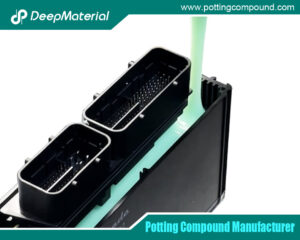
What Are the Core Differences Between Different Conformal Coating Types?
What Are the Core Differences Between Different Conformal Coating Types? Conformal coatings are thin polymeric films applied to electronic circuits to protect them from environmental
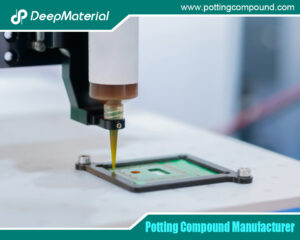
The Benefits of Conformal Coating for Electronics Products
The Bbenefits of Conformal Coating for Electronics Products In the world of electronics, where devices are increasingly compact and exposed to harsh environments, protecting sensitive
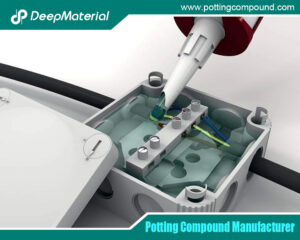
Conformal Coating Spray
Conformal Coating Spray In the fast-paced world of electronics, protecting printed circuit boards (PCBs) from environmental hazards is essential to ensure reliability and longevity. Conformal
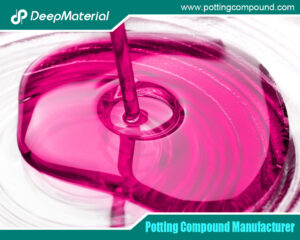
UV Curing Potting Compound
UV Curing Potting Compound In the rapidly evolving landscape of electronics and advanced manufacturing, protecting sensitive components with speed and precision is critical. UV curing
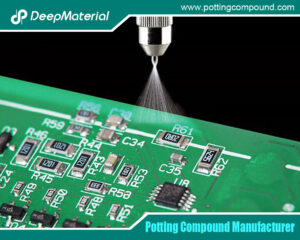
The Ultimate Guide to Electrical Potting Compound and Market Application
The Ultimate Guide to Electrical Potting Compound and Market Application In the modern world of electronics, where devices are increasingly compact and exposed to harsh

The Top Polyurethane Potting Compound
The Top Polyurethane Potting Compound In the fast-evolving world of electronics and industrial manufacturing, protecting sensitive components from environmental hazards is critical to ensuring reliability



